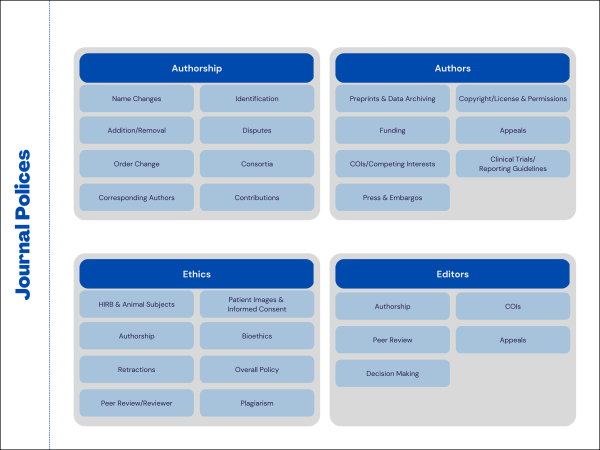First posted on the ORIGINal Thoughts Blog
By Jennifer Mahar
Consultant and Client Coordinator, Origin Editorial
Take Home Points:
Policies are the foundation that we build our workflows on in the editorial office. Policies are a set of rules for your journal to follow to retain consistency in your procedures and workflow. Think of them as a houseꟷyou need to fill your house with the things that will help you live. Throughout the course of this series of posts published over the next several months, we will explore policies that should be established in an editorial office. Policies can be simple or elaborate, but should ultimately help effectively support your authors, reviewers, editors, and editorial office. Just like your chairs and table support your dinner and your computer, your policies should be able to support your editorial office.
As we step through this series we will give tips, tricks and suggestions for your policies, but at the end of the day the number one take away is that you should have a policy. Your policy is your own to write and enforce, but a lack of a policy leaves the door open for you, your editorial office, and your editors, reviewers, and authors. There can be legal, ethical, and social implications if these doors are left open. We always complain that authors do not read our information, but they are quick to point out a lack of informationꟷor if information conflicts or is confusing on your website. So, I contend they are readingꟷbe sure to provide them with useful guidance. Below I share with you three key tips for writing effective policies.
Clarity
The first tip for writing policy is to be as clear as possible. Write, write, and re-write the policy. Have a non-native English-speaking colleague review your policy. Words have different meanings in different languagesꟷmaking sure you are being as clear and concise as possible is paramount for everyone on your team and anyone reading your policies. I’ll never forget when reviewing instructions with a client where we removed the word ‘skip down to section X’ and we had a vision of an author skipping around in their office while trying to figure out what we were trying to convey.
Transparency
Policies should be as outward facing and as transparent as possibleꟷtransparency allows for everyone to be on the same page when addressing an issue; big or small. There are times when policies may need to be held in the editorial office onlyꟷfor example, if you state in your instructions to authors that you only allow 3,000 words for each submission but would actually consider 20% more. This would be considered an internal discretionary policy to be administered within the editorial office.
Documentation
When your policies are outward facing this is your documentation. Every editorial office should have a policies and procedures manual to assist with maintaining your editorial office. Your procedures documentation should define all of your policies and explain how to administer each policy within your editorial office. Your procedures are the way in which you operate in your editorial office. It can be as simple as a one-page document that sends the user to the URL where your policies live or it can be an in-depth guide held in a common accessible space on a secure server. Whatever method you choose, have one!
The policies we will explore in this series will include but are not limited to:
If there are any policies, you’d like to see us address that are not listed above, please reach out with your suggestions to me at info@kwglobal.com.
Acknowledgements
I would like to thank Erin Landis for assistance with figure design.






